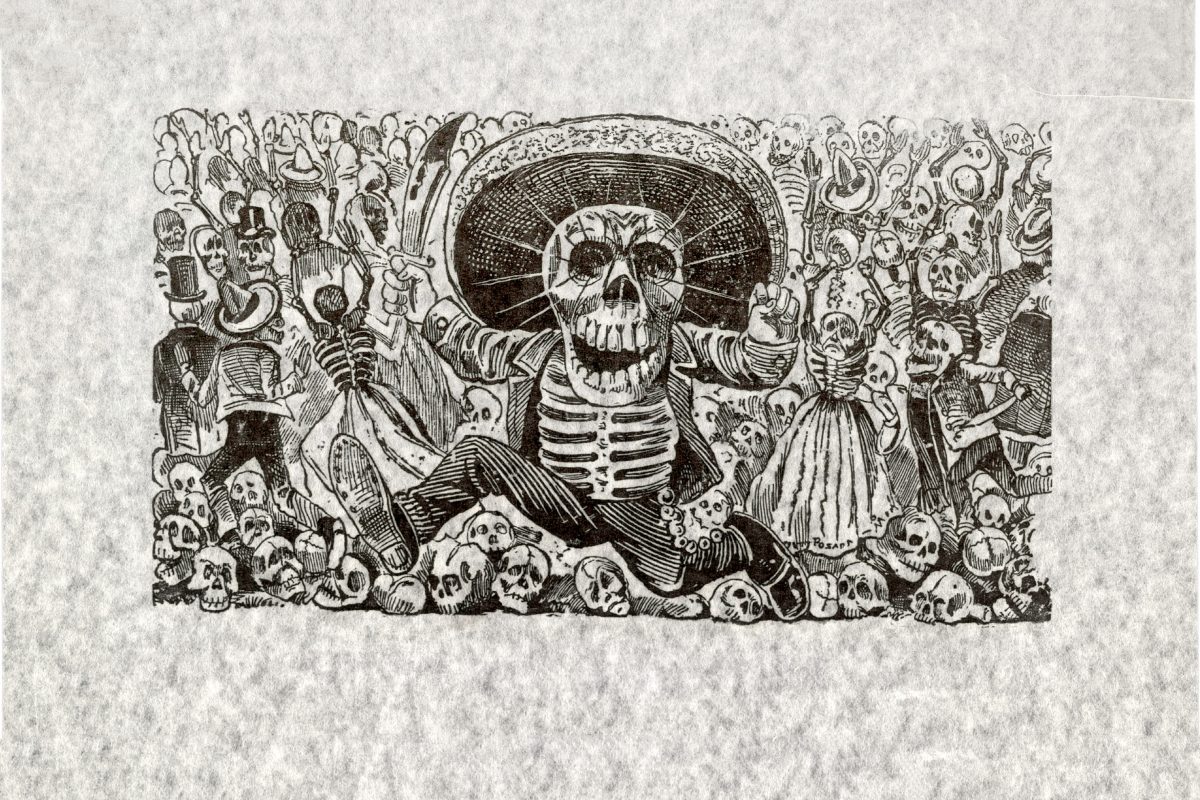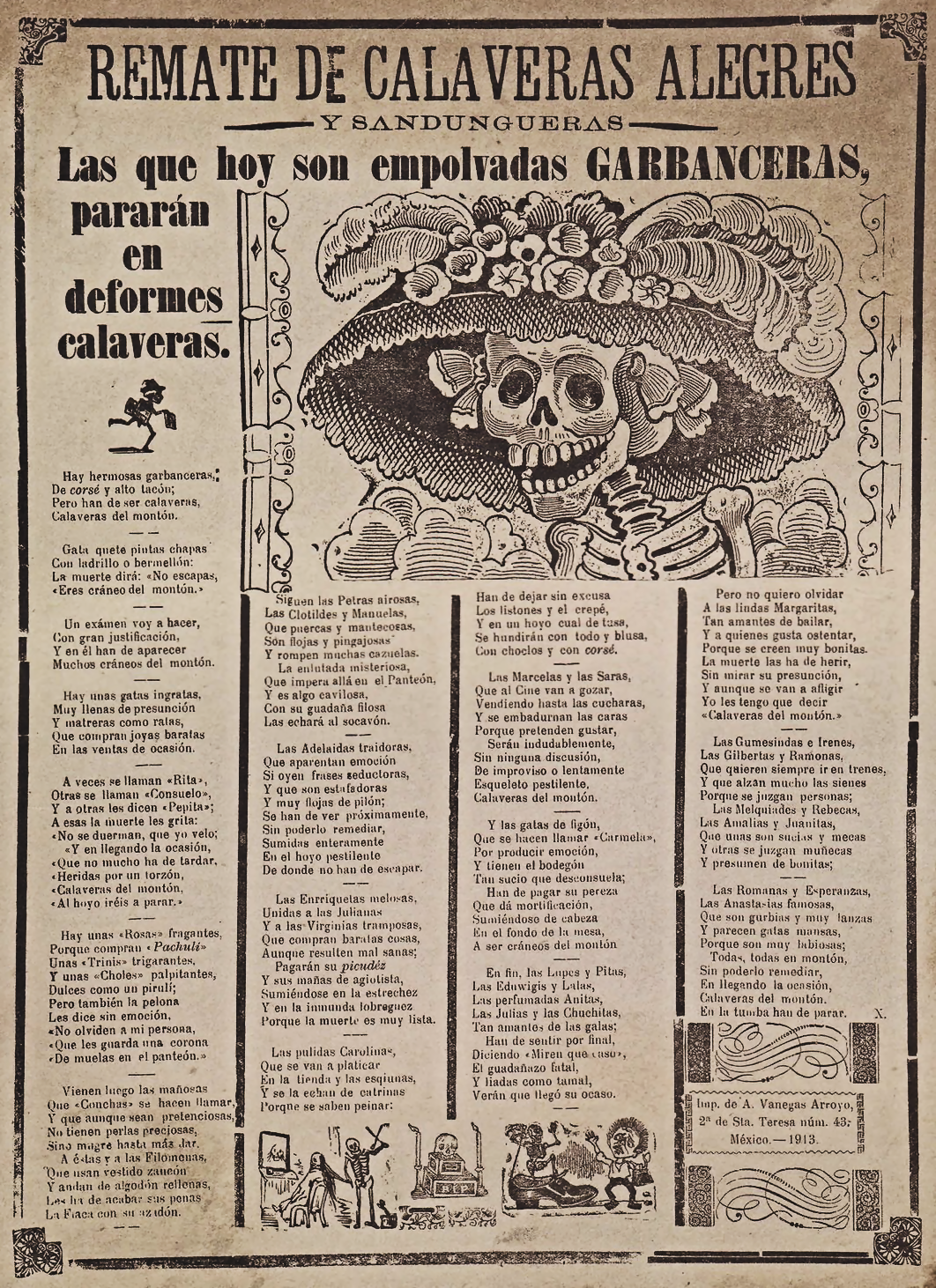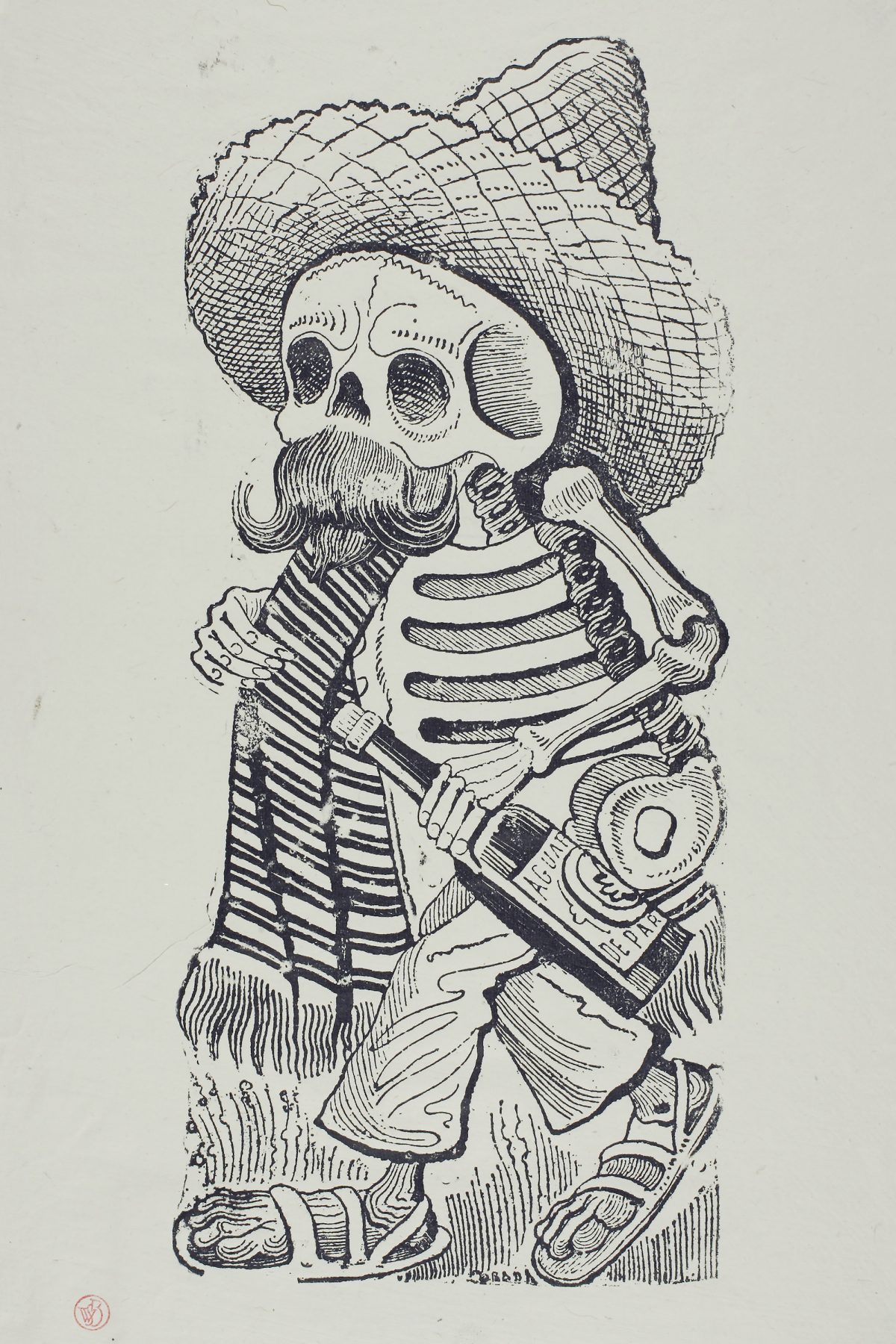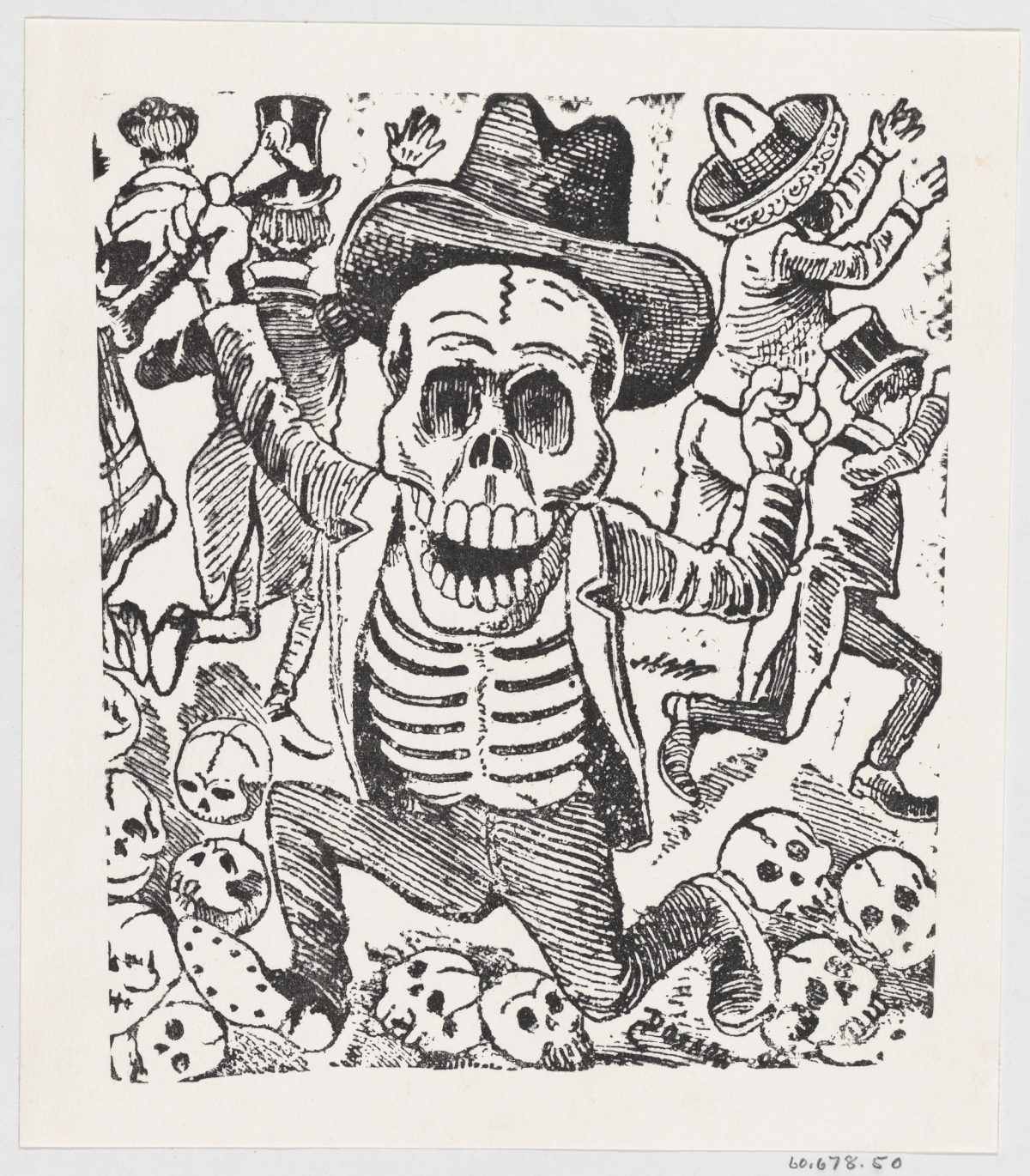“Death is democratic”
– José Posada
Mexican illustrator José Guadalupe Posada (1851 – 1913) is best remembered for his calaveras, representations of the human skull and skeleton now seen in Mexico’s annual celebration The Day of the Dead (Día de Muertos; October 31st – November 2nd).
Posada began creating his memento mori in 1880 for publisher Antonio Vanegas Arroyo’s broadsides, coloured one page news sheets aimed at the working class. They were sold in markets, at festivals and on the streets.
Posada depicted animated skeletons at work, dancing, living it up, playing instruments, mourning the dead, illustrating rhyming ballads (corridos) and stories about love affairs. The stories and Posada’s art expressed the social and political concerns of the period. Death lampooned the vain and rich, including Mexico’s dictator Porfirio Díaz. In Posada’s calaveras, shorn of finery and rank, everyone was equal.
One enduring image is La Calaera Catrina or Catrina Ljazmun a Calavera Garbancera (‘Dapper Skeleton’, ‘Elegant Skull’), a 1910–1913 zinc etching which has become an icon of The Day of the Dead.
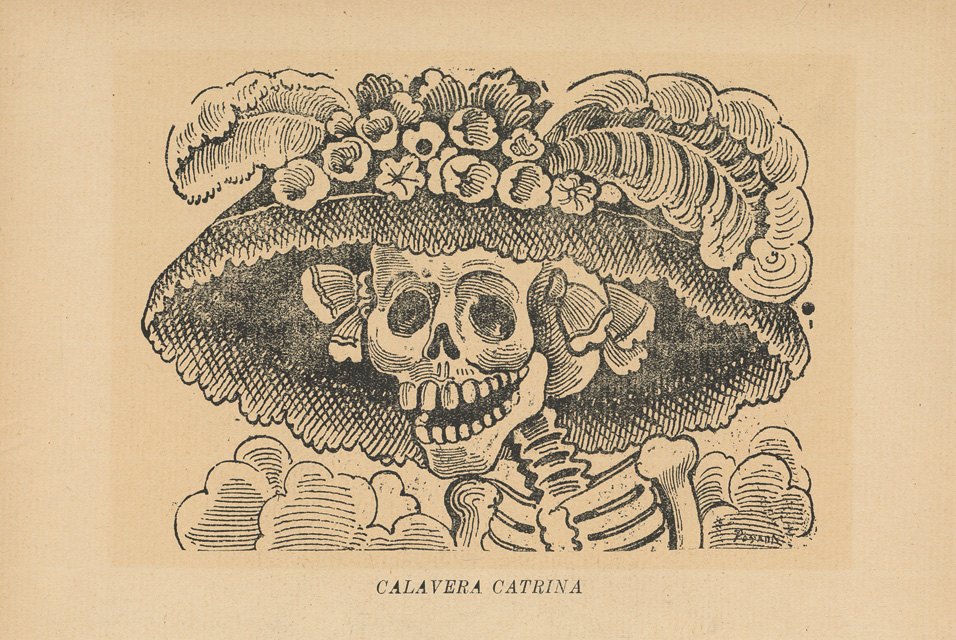
Calavera de la Catrina (Skull of the Female Dandy), from the portfolio 36 Grabados: José Guadalupe Posada, published by Arsacio Vanegas, Mexico City, c. 1910, zinc etching – Buy Prints and more here.
“La Catrina has become the referential image of Death in Mexico, it is common to see her embodied as part of the celebrations of Day of the Dead throughout the country; she has become a motive for the creation of handcrafts made from clay or other materials, her representations may vary, as well as the hat.”
– J.G. Posada.
On January 20th 1913, 3 years after the start of the Mexican Revolution, José Guadalupe Posada died penniless. He was buried in an unmarked grave. In the 1920s his work was rediscovered and hailed by French ex-patriot artist Jean Charlot who described Posada as “printmaker to the Mexican people”.

A skeleton dressed as a military figure (vignette for the feast of the dead) ca. 1890–1910 José Guadalupe Posada
Click on any of the images to be taken to the Calaveras page in the shop, where you can buy T-shirts, prints, magnets and Tote bags featuring Posada’s brilliant creations. Order yours here.

Skeletons (calaveras) dancing and drinking, corrida in bottom section Ca. 1910 José Guadalupe Posada

Two elegantly dressed skeletons walking, from a broadside entitled, ‘El Gran Panteon Amoroso,’ published by Antonio Vanegas Arroyo. ca. 1880–1910 José Guadalupe Posada

A male skeleton walking behind a female skeleton (vignette for the feast of the dead) ca. 1890–1910 José Guadalupe Posada

A male skeleton on his knees before a female skeleton (vignette for the feast of the dead) ca. 1890–1910 José Guadalupe Posada

A skeleton wearing a hat having a drink (vignette for the feast of the dead) ca. 1890–1910 José Guadalupe Posada

A skeleton picking crops in a field while carrying a baby skeleton on her back ca. 1880–1910 José Guadalupe Posada
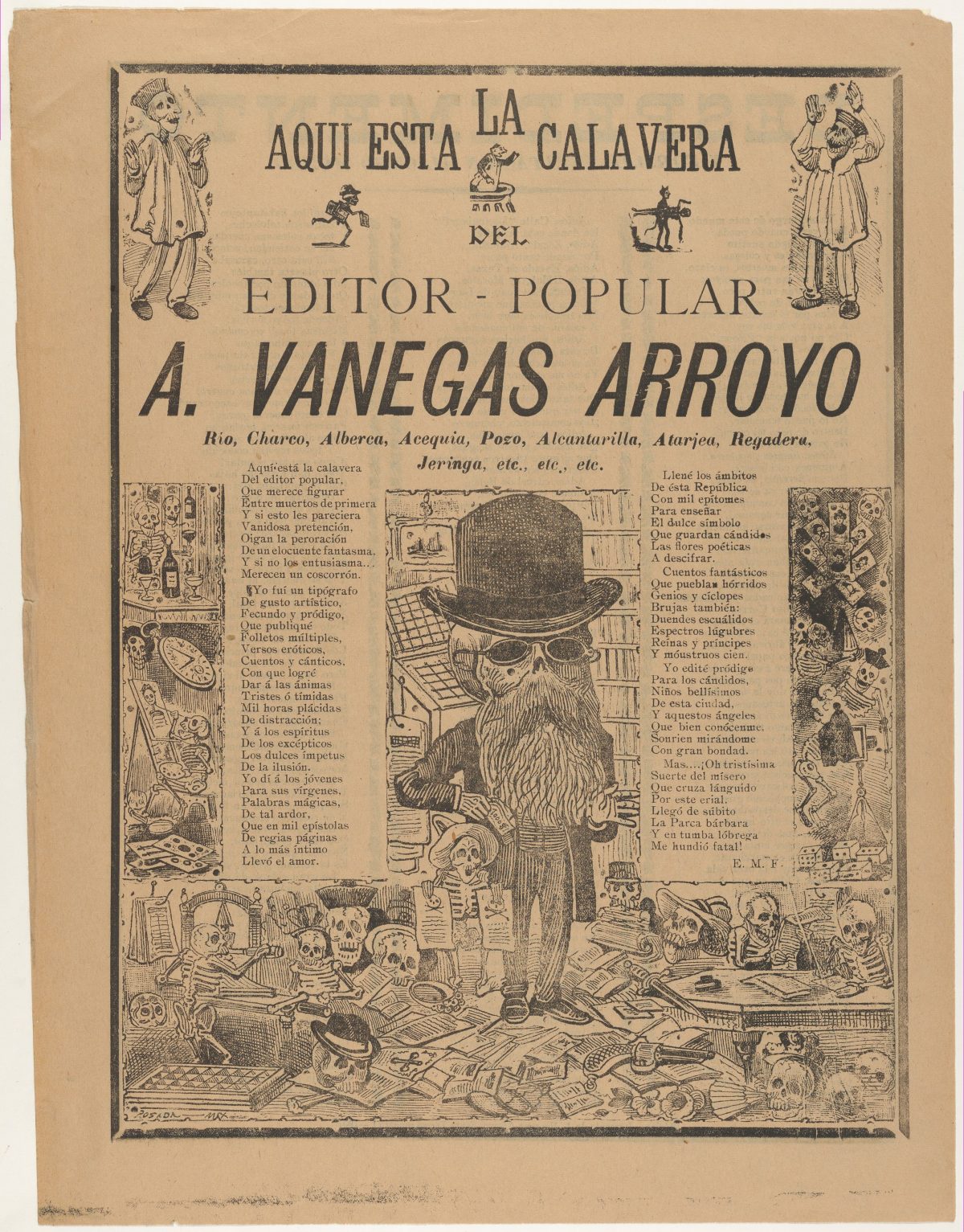
The bearded skeleton wearing a top hat and glasses represents Antonio Vanegas Arroyo (1852 – 1917) who published many of Posada’s prints. The verses around the image list his range of publications. His commercial success is indicated by the thousand-dollar note clutched in his right hand. Such humorous mocking of a man who was a friend and patron of Posada is part of the semi-satirical tradition of the calavera (skeleton). The two scenes behind Vanegas Arroyo reflect aspects of his profession. The shop in the upper section represents the commercial side of his profession. Below are skeletons in a workshop engaged in proofreading and operating the press – 1907.
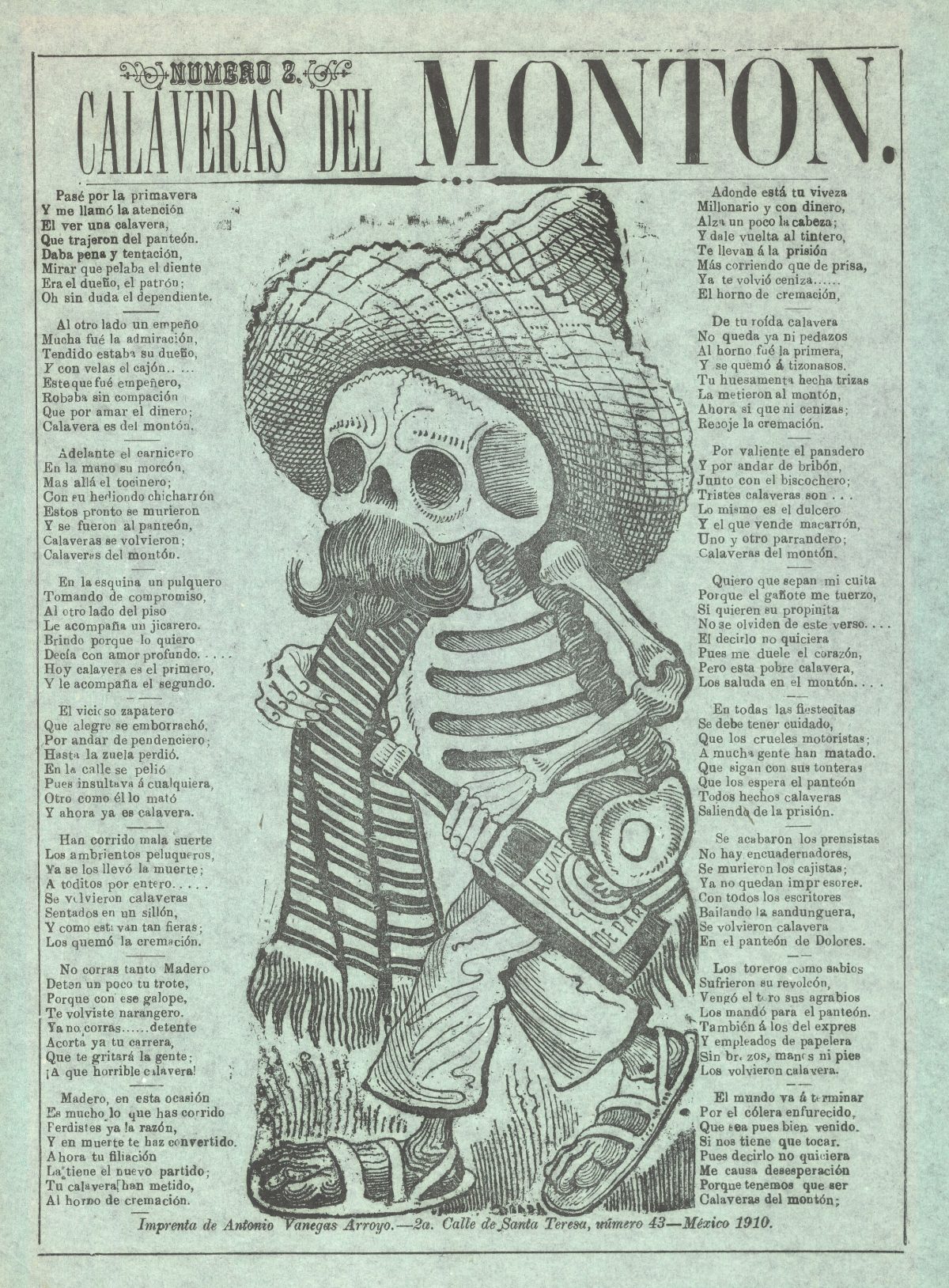
Broadside shows the skeleton of a drunken peon wearing a sombrero, serape, and sandals, holding a bottle of Aguardiente de Parras–a reference to Madero’s family’s maguey plantation and distillery operation. The distinctive mustache and beard further identify the calavera as Madero.

A skeleton selling hot liquid in basins, from a broadside entitled ‘Una Calavera Chusca’ Artist-José Guadalupe Posada (Mexican, 1851–1913) Date-ca. 1880–1910 Medium-Wood engraving

A skeleton selling plucked chickens from a broadside entitled ‘Una Calavera Chusca’ Artist-José Guadalupe Posada (Mexican, 1851–1913) Date-ca. 1880–1910 Medium-Wood engraving

Profile of a female skeleton with a fur vest, from a broaside entitled ‘La Calavera de Cupido Artist-José Guadalupe Posada (Mexican, 1851–1913) Date-ca. 1880–1910 Medium-Etching on zinc

A skeleton in farming clothes speaking to a skeleton in a dress, from a broadside entitled ‘La Calavera de Cupido’ by José Guadalupe Posada Date-ca. 1880–1910 Medium-Etching on zinc

A skeleton in a torero costume turning away from a kneeling skeleton in a shawl and dress, from the broadside El Gran Panteon Amoroso – José Guadalupe Posada, 1880–1910 Medium-Etching on zinc

Two skeletons smiling and dancing Artist-José Guadalupe Posada (Mexican, 1851–1913) ) Date-ca. 1880–1910
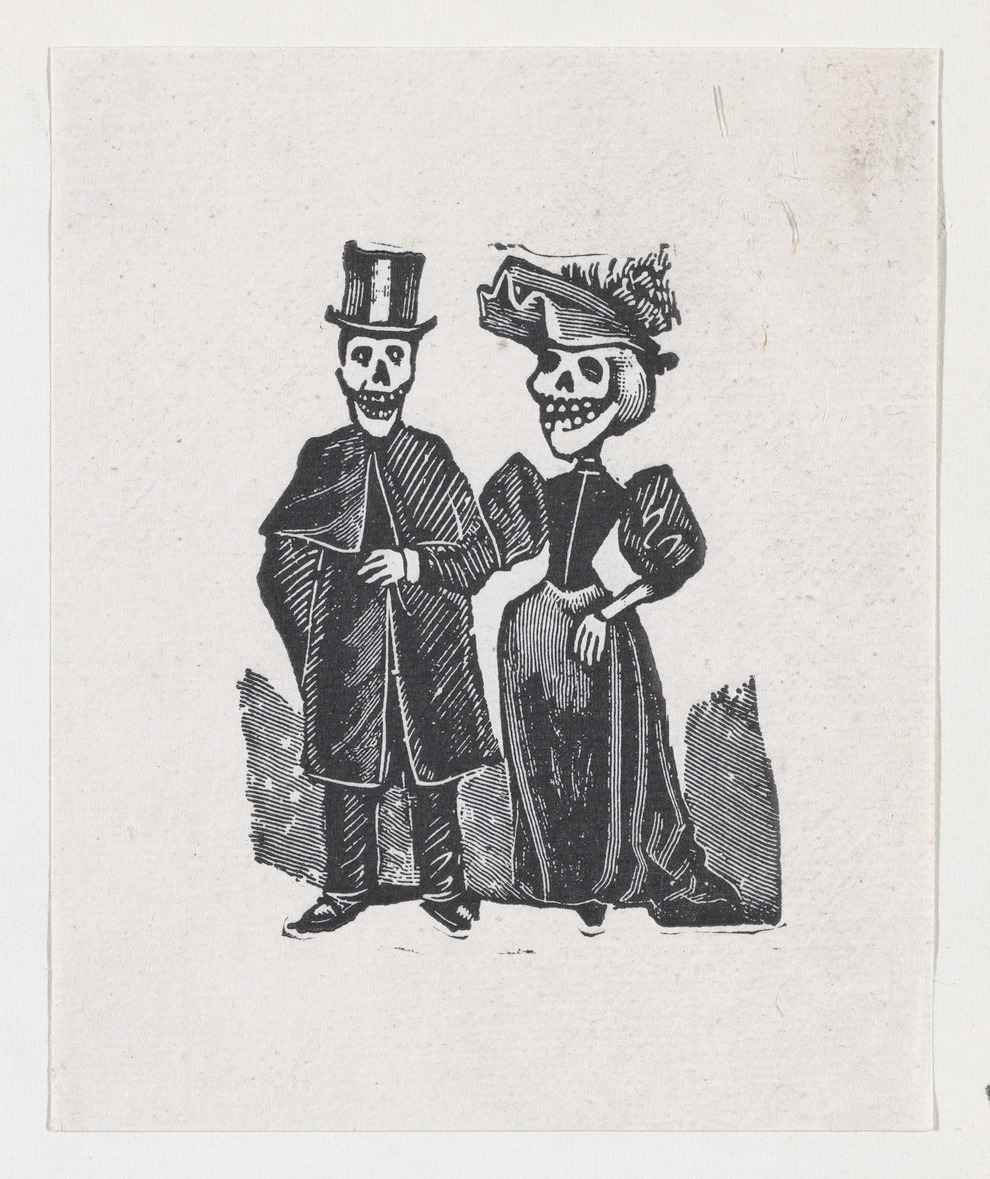
Two elegantly dressed skeletons walking, from a broadside entitled, ‘El Gran Panteon Amoroso 1880–1910 – Medium-Etching on zinc

Skeletons as artisans Artist-José Guadalupe Posada (Mexican, 1851–1913) Date-ca. 1890–1910 Medium-Wood engraving

Skeletons (calaveras) riding bicycles Artist-José Guadalupe Posada (Mexican, 1851–1913) Date-ca. 1900 Medium-Etching on zinc

A skeleton covered with a sheet crying in a cemetery, from a broadside entitled ‘ Calavera llorando el hueso’ Artist-José Guadalupe Posada (Mexican, 1851–1913) Date-ca. 1880–1910 Medium-Wood engraving

Cupid’s Skeleton Artist-José Guadalupe Posada (Mexican, 1851–1913) – Publisher-Antonio Vanegas Arroyo (1850–1917, Mexican) – Date-ca. 1900–1910 – Medium-Photo-relief and letterpress on buff paper

Skeletons hawking their wares and shouting about teetotalers, drunkards, old men and kids, tomcats and working girls Artist-José Guadalupe Posada (Mexican, 1851–1913) Date-ca. 1900–1910

A skeleton wearing a bishop’s mitre reading a book (vignette for the feast of the dead) Artist-José Guadalupe Posada (Mexican, 1851–1913) Date-ca. 1890–1910 Medium-Metal-plate engraving

A male and female skeleton talking (vignette for the feast of the dead) Artist-José Guadalupe Posada (Mexican, 1851–1913) Date-ca. 1890–1910 – Medium-Metal-plate engraving

Female skeleton playing the guitar (vignette for the feast of the dead) Artist-José Guadalupe Posada (Mexican, 1851–1913) Date-ca. 1890–1910

A female saint standing with a cavalier and surrounded by angels and skeletons Artist-José Guadalupe Posada (Mexican, 1851–1913) – Date-ca 1890–1910

Two skeletons smiling and dancing Artist-José Guadalupe Posada (Mexican, 1851–1913) Printer-José Sanchez (Mexican, active ca. 1900–1910) – Date-ca. 1880–1910

Two male skeletons in suits dancing (vignette for the feast of the dead) Artist-José Guadalupe Posada (Mexican, 1851–1913) Date-ca. 1890–1910 – Medium-Metal-plate engraving
Buy prints, T-Shirts and magnets featuring José Guadalupe Posada’s calaveras in the shop.
Via: The Met
Would you like to support Flashbak?
Please consider making a donation to our site. We don't want to rely on ads to bring you the best of visual culture. You can also support us by signing up to our Mailing List. And you can also follow us on Facebook, Instagram and Twitter. For great art and culture delivered to your door, visit our shop.
